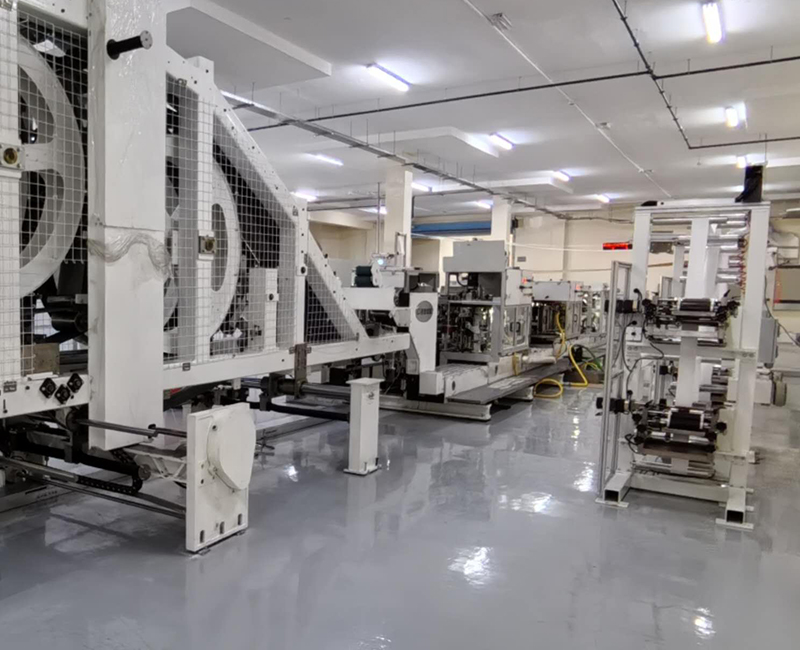Innovative High-Speed Gluing Systems Revolutionize Paper Bag Manufacturing Efficiency
Release time:2025-05-14 Classification:Knowledge
The evolution of packaging technology has reached new heights with the development of advanced high-speed gluing systems tailored for paper bag production. As sustainability drives demand for eco-friendly packaging solutions, manufacturers are prioritizing equipment that combines precision, speed, and reliability. Modern high-speed gluing systems address these needs by optimizing adhesive application processes, reducing waste, and enhancing throughput. This article explores the design principles, operational advantages, and transformative impact of these systems on paper bag manufacturing workflows.

Core Technology Behind High-Speed Gluing Systems
At the heart of a high-speed gluing system lies a meticulously engineered mechanism designed to handle rapid production cycles without compromising accuracy. These systems integrate several critical components:
- Automated Adhesive Dispensing Units: Equipped with precision nozzles and flow control valves, these units ensure consistent glue distribution across paper surfaces, even at speeds exceeding 500 bags per minute.
- Adaptive Temperature Regulation: Advanced thermal management maintains adhesive viscosity within optimal ranges, preventing issues like premature drying or uneven bonding.
- Multi-Axis Motion Control: Synchronized servo motors enable complex glue patterns (e.g., spot, strip, or edge gluing) while accommodating diverse bag designs.
- Real-Time Quality Monitoring: Integrated vision systems and sensors detect application anomalies, triggering instant adjustments to minimize material waste.
Operational Advantages for Paper Bag Production
- Unmatched Throughput: By reducing cycle times by up to 40% compared to conventional systems, manufacturers achieve higher output with existing floor space.
- Material Efficiency: Precision glue application decreases adhesive consumption by 15-25%, directly lowering production costs and environmental impact.
- Enhanced Bond Integrity: Uniform glue layers create stronger seams, critical for heavy-duty bags carrying weights up to 25 kg.
- Quick-Change Flexibility: Modular designs allow rapid reconfiguration between different bag sizes (e.g., flat-bottom, SOS, or pinch-bottom styles) within minutes.
Technical Innovations Driving Performance
Recent breakthroughs in high-speed gluing technology include:
- Non-Contact Spray Application: Ultrasonic spray heads deposit micron-thin adhesive layers, eliminating nozzle clogging and reducing cleanup downtime.
- Self-Learning Algorithms: Machine learning models analyze historical production data to predict and compensate for environmental variables like humidity fluctuations.
- Energy Recovery Systems: Regenerative braking in linear actuators converts kinetic energy into reusable power, cutting energy costs by up to 18%.
- Hybrid Adhesive Compatibility: Systems now support water-based, hot-melt, and bio-sourced adhesives, enabling compliance with food-grade and recyclability standards.
Industry Applications and Sustainability Impact
High-speed gluing systems are transforming multiple paper bag verticals:
- Retail Packaging: Enables mass production of premium branded bags with intricate glued handles and reinforced bases.
- Industrial Bulk Bags: Ensures leak-proof seals for chemical-grade and agricultural packaging.
- E-Commerce Solutions: Facilitates durable, lightweight mailing bags with tamper-evident glued closures.
From an environmental perspective, these systems support circular economy goals through:
- Reduced adhesive overspray (≤2% material loss)
- Compatibility with recycled paper substrates
- Lower carbon footprint per 1,000 bags produced
Future Development Trends
Emerging advancements in high-speed gluing systems focus on:
- Nanotechnology Adhesives: Development of ultra-thin, high-strength bonding agents requiring 50% less material.
- IoT Integration: Cloud-connected systems enabling predictive maintenance and remote parameter optimization.
- AI-Driven Pattern Recognition: Adaptive gluing paths that automatically adjust to paper grain variations.
- Hybrid Laser-Gluing: Combining laser surface treatment with adhesive application for instant curing on moisture-sensitive materials.
As paper bag manufacturers navigate increasing demand and sustainability mandates, high-speed gluing systems have become indispensable tools for maintaining competitive advantage. By merging engineering precision with intelligent automation, these systems not only elevate production efficiency but also enable the creation of durable, eco-conscious packaging solutions. Continuous innovation in adhesive technologies and process control ensures that high-speed gluing will remain a cornerstone of modern paper converting operations, driving the industry toward smarter, cleaner, and more profitable manufacturing paradigms.






